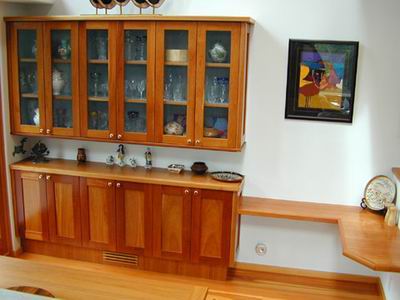Question
First, a little background. I am a custom closets manufacturer. I have contractors and dealers that I sell to wholesale in the NY Metro area.
The way we produce parts currently is cutting on the beam saw, then edgebanding and the boring and routing on the Pt-to-Pt or on our 75 spindle CNC borer. What we find is that we handle the parts too many times, in sorting and packing the jobs. We basically combine a couple of jobs to cut at the same time. We usually will cut anywhere between 20-30 sheets together.
The parts have to be separated into verticals and then different height verticals, which will proceed to the PT-to-PT or the CNC line boring machine. Then we have the various shelves with varying depths and heights that will only be edgebanded. We also have shelves that will get cams, where these will get two operations, edgebanding and cam boring. Lastly we have some miscellaneous parts such as shelves that need to be routed for locks, or radiused hutch verticals, etc.
Our beam saw mixes all the parts together. I am looking for ideas to build carts that will help sort the parts as they come off the saw. Currently we have 10 carts, regular 2X4 slapped together with a flat top. I figure we need to build at least 20 carts, as I would like to separate each job and leave it on a cart until the contractor/dealer comes to pick it up.
Hafele/Shop Carts has a cart that might work for us. I was wondering if any of you has built a cart that can achieve the above. We also have roller conveyors that we bought in an auction, but don't really know how to place, as we don't won't to block any of our machines. If anyone can share pictures or ideas on how to build a cart for the above, it will be greatly appreciated
Forum Responses
(Cabinetmaking Forum)
From contributor J:
I think I would standardize the parts I could (parts that share a common dimension with all jobs, usually depth). I cut all my common depths for cabinets 23.75" x 97", 21" x 97", 11.75 x 97" and so on, and store them in pallet racking near my Striebig. When the job comes in I pull from that rack, and cut all parts needed for one job. It goes on its own set of carts, and proceeds to EB, boring, routing, hardware, etc.
While that's being done I can start another job right behind it, on its own set of carts. And another behind that.
With places going out, you can purchase carts that are all ready to go with racks and dividers for less than the cost of a good set of casters. Also, lineberry carts roll a lot easier, with heavier loads, and can be had for cheap now also, and would make a good platform to base your carts on. Watch the auctions.
When we went to conveyors we had to rearrange some of the equipment but it has been well worth it. Before conveyors you could never find an empty cart (we had over 100). If you did find a cart you had to unload someone’s unknown junk and push it back to the starting point. A total waste, my customers weren't interested in paying for all that wasted motion. I imbedded the rails for the transfer cars into the concrete floor so they aren't a trip hazard. The system consists of 440' of 24" roller conveyor set at 24" high, all bought used and reconditioned in our shop. 3 transfer lines with 5 transfer cars that I designed and had a welding shop make. You can buy ready made components but we were on a limited budget and did most of the work during our slow season. We still have some carts for the molding area. The conveyor is not bolted to the floor so we can easily move it in 10' pieces when we need access to reach the lights, electrical or duct work overhead. It (conveyors) was greatly resisted before being installed but now no one would go back to carts.
